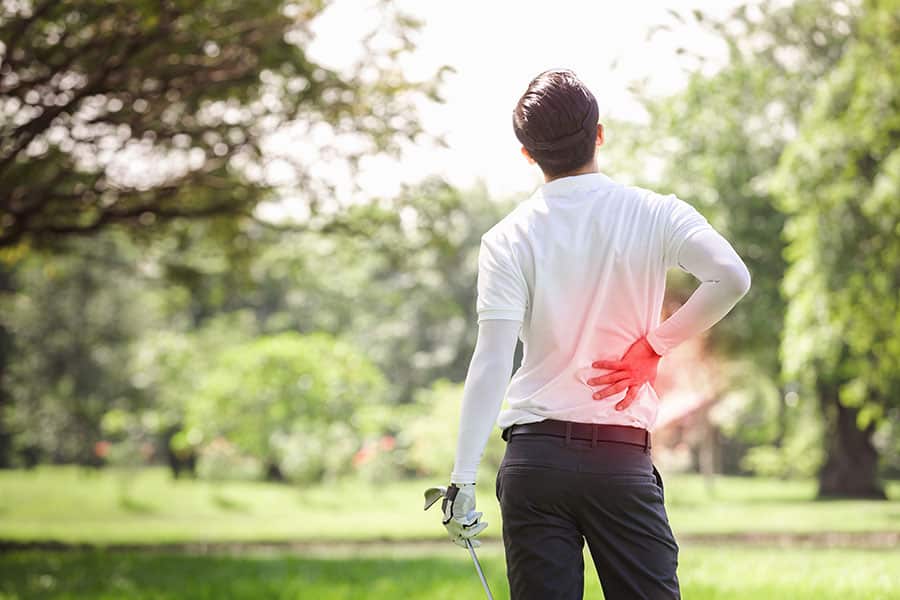Do you enjoy golfing but tend to find yourself suffering from lower or upper back pain? Back pain is the most common golf related injury. You may experience pain with each swing, only when following your round, or consistent pain that keeps you off the green.
The goal is to play pain-free while at the golf club. Many people think that back pain is a condition, but in reality, lower and upper back pain is a symptom that needs to be evaluated by a medical professional.
Most Common Golf Injuries
There are four main categories of golf related injuries resulting in lower and upper back pain:
- Thoracic spine strains and lumbar spine strains, most commonly known as upper and lower back pain respectfully. These are the muscles that are tight or injured from excessive strain.
- Disc herniations, refers to an issue in the cushions between the bones (vertebrae) of the spine.
- Facet arthritis refers to when the cartilage deteriorates in the back.
- Accidents, these are simple non-avoidable injuries such as tripping on the green.
Symptoms of Back Pain
It is important to know the symptoms of back pain because what you experience may be different from what a friend or family member may experience. You may experience lack of mobility, aching pain throughout the back or shoulder blades, shooting or stabbing pain anywhere in the back, decreased flexibility, and even pain or weakness in your legs.
Spine surgeons and sports medicine teams highly recommend early intervention to prevent further damage and to avoid further disc problems. There are many causes for back pain such as herniated discs, compression fractures, strained muscles, and much more. This is why it is always imperative to speak with a medical professional regarding any back pain.
Get Back Your Normal Life Again
As pain specialists, we can guarantee that we are more than qualified in alleviating your pain and treating your condition.
Ways to Avoid Back Pain
The risk of injury during a golf game is always present, however, you can play golf and be proactive in injury prevention. The most common way to avoid lower and upper back pain is to complete a warm-up prior to hitting the first hole. The best way to warm up is to stretch, which will protect your core muscles and reduce muscle strain. The most common warm-up tactics are the easiest – complete a few practice swings.
Another way to protect your back while playing golf is to stay fit in between games. Although golf is an excellent source of exercise, it is important to stay active in between games.
The Golf Swing and the Lower Back
Why do golfers tend to experience lower back pain? Lower back pain from golf comes from the form the golfer uses at the tee. During the time from the setup, tee, and swing the back can see intense compressive force on the spine.
Golfers generate as much as 1700 pounds of force during the swing. As little as 1300 pounds is all that it takes to herniate a disc.
The best way to combat this extreme force is to strengthen core muscles, learn to swing properly, and to swing with less force. Knowing your rotational force is a vital skill that allows for a great game every game. Swinging with less force may be difficult for competitive golfers to accept. However, it is crucial to avoid injury.
Strengthening the core muscles will also substantially decrease the likelihood of back pain. During the warm-up is the best time to work on your swing mechanics. This may be working on posture or changing the force that is used during the swing.
Diagnosis of Back Pain
When a medical professional is attempting to diagnose back pain, there are a few tests that may be completed. Physicians may complete blood and urine tests to rule out infections. Other tests that can be conducted are an x-ray, EMG, MRI, or a CT scan.
An x-ray can identify broken bones or fracture while the EMG specifically analyzes how your muscles respond to signals from your brain. The MRI is used to look at muscles, ligaments, and tendons. It can also identify tumors, herniated discs, and inflammation. Lastly, the CT scan can identify spinal stenosis and ruptured discs.
Back Pain Treatment at Arizona Pain and Spine Institute
Golfing with upper back pain, or lower back pain, is not pleasant. If you are experiencing pain consult with a medical professional. There are many ways to treat back pain from golfing.
After a medical diagnosis, there are a few ways to treat back pain at home. The most common treatments are using heat or ice, anti-inflammatory drugs, and pain relieving ointment to quickly remedy the pain.
Chronic back pain may require a more aggressive form of treatment such as physical therapy, lifestyle changes, steroid injections, massage therapy, or surgery. Surgery is not always needed and is a last resort.
If you are experiencing chronic back pain, book an appointment with us today!

